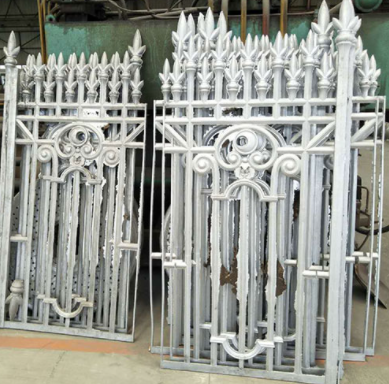Across all of the manufacturing, the question “Which aluminum casting method should I use?” can only be solved by asking and answering further questions about the application at hand, the requirements of the project overall, and your needs as a customer. This is as true for aluminum casting methods as it is for any other process. The benefits and applications of using aluminum casting techniques for a project are vast, but there are several further choices to consider when deciding how to cast aluminum parts for your application.
In this piece, we'll quickly summarize the differences between the available methods, and provide an easy guide to help you determine the right choice.

Aluminum Casting Fence
Aluminum Casting Methods: The Three Processes
Three primary metal casting methods can be used to cast aluminum: die casting, permanent mold casting, and sand casting. The methodology behind each of these metal casting techniques is as follows:
Sand casting: In this method, a mold is created from a sand mixture, containing a cavity into which the molten aluminum alloy from which your part will be created is poured. Once the aluminum cools and solidifies, the sand mold is broken away from the part.
Permanent mold casting: As the name implies, in this aluminum casting method, the mold is not broken away (as it is in sand casting). A reusable metal mold is created, and the cavity is filled with aluminum via gravity. The mold is then separated after cooling and the finished part ejected or removed.
Die casting: Die casting is very similar to permanent mold casting, except that the molten aluminum is injected into the cavity under pressure, rather than poured and filled via gravity. Aside from this functional difference, the two processes are similar, but we'll discuss the differences in the output below.
Which Aluminum Casting Technique Should You Choose?
Along with a brief overview of each factor, we'll note which of the three processes meets that need best:
Speed: Sand Casting automated processes, like at LeClaire Manufacturing, provides a high output of parts in a short amount of time when compared to permanent mold processes. Die casting provides the greatest speed in manufacturing, thanks to the pressurized injection process.
Strength: Permanent mold casting provides the greatest material strength in the finished product. Although similar to die casting, the pieces produced via permanent mold casting have an advantage in this area due to the nature of the process.
High quantities: Sand Casting offers the most advantageous balance between higher quantities and tooling costs, while a permanent mold is a closer second. For quantities well in excess of 100,000, however, die casting may be the better choice.
Prototypes and short runs: Sand casting is the method of choice when only a few pieces are needed, thanks to its low tooling cost.
Surface finish: Permanent mold casting and die casting offer the smoothest surface finish out of the mold.
If you have additional questions about the right process for you, LianJiang is ready to help. To learn more about our aluminum casting services, contact us today to receive a quote.





Comments
All Comments ( 0 )